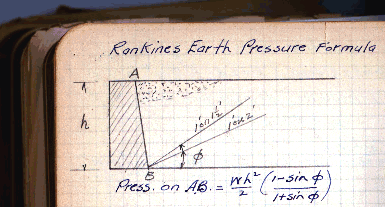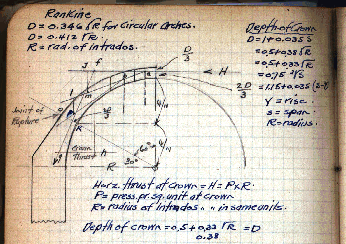Trautwine's Pocket-book
Today, a look at two very different faces of engineering. The University of Houston's College of Engineering presents this series about the machines that make our civilization run, and the people whose ingenuity created them.
In 1906 Loren Plummer, a construction engineer with Lackawanna Steel in Buffalo, bought this 18th edition of Trautwine's Civil Engineering Pocket-Book. Now the binding is flaking, and the gilt-edged pages are falling out. Plummer used this book heavily. A McDonalds-like note in front says they've sold 80,000 copies since the 1st edition in 1875. The preface says there's no errata list because there are no errors to correct.
I started out in engineering 43 years after this book was printed, and that's already 47 years ago. When I was a student, I was closer in time to this book than I was to our life today -- closer to a vastly different engineering world.
Let's look through this window into the past. "Comparatively few engineers are good mathematicians," the preface begins.
And it is fortunate that such is the case; for nature rarely combines high mathematical talent, with that practical tact, and observation of outward things, so essential [for an] engineer.
Mathematics is a big part of the book's 1100 pages. But here mathematics means tools for calculation -- logarithms, trig functions, tables of interest, square roots, and chords of circles. No tables of integrals -- nothing at all on calculus.
For the rest, we read about dams and weirs, beams, water pipes, and route surveying. Where would you go today to learn how to lay railroad track! But there it is.
It ends with a section of blank lined paper. After all, any really useful handbook must be partly handmade. It should include odd items that only the owner needs. Plummer doesn't disappoint us. He fills those pages with beautifully rendered notes, drawings and calculations -- of beams, earthworks, and arches.
Now and then, in my class this semester, I wandered away from all the math and analysis that is modern engineering, and I talked about locomotives, valves, and refrigerators. Each time I did, the students showed an almost guilty fascination. It is as though the brakes, cables, and bearings in this old handbook have become forbidden fruit.
That tension -- right in my own classroom -- reminds me that we build everything in two places. We build in the mind, and we build in the world. In the last century we talked only about building in the world. Now we talk about mathematics and analysis -- about building in the mind. But my students see the onesidedness. They know what their teachers forget.
Pause a moment, they tell me. Tell us a little about the other world -- the world this forgotten engineer, this Loren Plummer, once lived in -- this world of stone, iron, and external beauty.
I'm John Lienhard, at the University of Houston, where we're interested in the way inventive minds work.
(Theme music)
Trautwine, J.C., Trautwine, J.C., Jr., and Trautwine, J.C., 3rd, The Engineer's Pocket-Book. 18th ed., New York: John Wiley & Sons, 1904.
I am very grateful to Engines listener Eric Erdmann for providing me with his old copy of Trautwine.


Images courtesy of Special Collections, UH Library
A century-old engineer builds America: Plummer's careful calculations from the margins of Trautwine's handbook